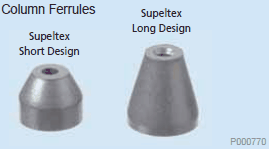Capillary Column Ferrule Selection and Installation
Robert F. Wallace
Reporter US Volume 27.3
Introduction
To provide a leak-tight seal, the ideal gas chromatography (GC) ferrule will accommodate column outside diameter (O.D.) variations, seal with minimum torque, and not stick to the column or fi ttings. The proper selection of any GC ferrule should be based on compatibility with the column material, temperature, connection requirements, and variation in column diameter. Supelco offers Supeltex™ and CapSeal Bullet™ ferrules to provide a leak-free connection for any application.
Choosing the Correct Ferrule Material
A proper ferrule for capillary GC is designed to seal tightly on all columns having the same nominal O.D., and should be made of material compatible with the column. As shown in Table 1, ferrule composition will dictate reusability and allowable injector and detector temperature. In multiple-use applications, the ferrule must resist deformation and the affects of high temperature. If you are using temperature-programmed analyses, the ferrule also must be resilient enough to maintain a good seal when column temperature and corresponding back pressure increase. Supeltex M-2A ferrules are multiple-use ferrules.
The outside diameters of equal O.D. columns often differ because tubing dimensions cannot be absolutely controlled. Soft ferrules, such as those made of graphite, usually are fl exible enough to adjust to these variations and will not stick to fi ttings or columns due to their natural lubricating characteristics. Graphite is one of the most thermally stable and chemically resistant materials. In a natural or vacuum environment, it does not melt when heated. In the presence of oxygen and temperatures above 450° C, graphite can oxidize. Ideal for capillary GC applications with its versatility, Supeltex M-4 (fl exible graphite) ferrules provide great sealability, ensuring a leak-tight seal for extended periods at high temperature.
The CapSeal Bullet ferrule, with its innovative design, provides a refi ned graphite ferrule with a clean sharp profile, and minimal flashing to ensure maximum sealing surface and minimal possibility of column contamination during installation. The graphite body in an aluminum base makes it easy to remove the ferrule from any fitting. The CapSeal Bullet ferrule allows low-torque sealing (effective at 1/8-turn past finger tight), and has a temperature limit of 450° C for both isothermal and programmed temperature use, under normal conditions.
Choosing the Correct Ferrule I.D.
Following the selection of the ferrule material best designed for your capillary column, next will be the selection of a size that matches the column. Before tightening, ferrules should fi t snuggly around the column because loose ferrules may crack or damage the column wall during tightening. This can cause leaks or column breakage after several heating and cooling cycles. Use 0.4 mm I.D. ferrules with 0.25 mm I.D. and smaller I.D. fused silica columns, 0.5 mm I.D. ferrules with 0.32 mm I.D. columns, and 0.8 mm I.D. ferrules with 0.53 mm I.D. columns.
Choosing the Correct Ferrule Shape
After selecting a ferrule material and I.D. that best fi ts the application, it is critical to use the proper ferrule shape, as shown in Figure 1, that is compatible with the column nut. An improper nut and ferrule combination will create dead volume between the ferrule and the portion of the injection port that is not swept by the carrier gas. This can result in poor chromatography as evidenced by fronting peaks and band broadening. To ensure the chromatography is the best it can be just follow these few suggestions. If you are using the original nut supplied for the injector and non-MS detector end of an Agilent® GC instrument, choose a Supeltex short design ferrule. For the MSD source nut of an Agilent instrument, the recommended ferrule is the Supeltex long design. On PerkinElmer® and Varian® GC instruments, the nut supplied with the

Figure 1.Column Ferrules
Column Installation
Correct installation of the ferrule is critical to column performance. Once the ferrule is properly sized, squarely cut the sealed capillary column end. To make the cut, Supelco recommends using a specialized tool, such as a Capillary Cleaving™ Tool or Shortix® Tubing Cutter, and inspecting the cut with a magnifier, such as a Coddington Magnifi er or Lenscope Illuminated Magnifier, to verify the cut is square. Column fragments or ferrule particles can contaminate the column, causing it to adsorb active analytes. Therefore, always keep the column end pointed toward the floor when cutting the end, or while installing the nut and ferrule. This will allow column fragments and ferrule particles to fall away from the column. Install the nut and ferrule on the column according to your instrument instructions. After ferrule installation, remove stubborn particles that may remain in the column end by cutting about one inch from the end of the column. Do this each time a ferrule is installed.
When installing a fused silica column in the injector or detector port, follow the instrument manufacturer’s recommended insertion distances. Otherwise, column performance may be adversely affected. Attach the column by inserting inlet and detector ends and handtightening the fittings. Use a wrench for final tightening. To avoid column damage, do not over-tighten.
Using the appropriate ferrule does not automatically ensure a leak-free seal. Whether installing a column in the GC or connecting it to a GC-MS system, failure to check all connections may cause unreliable analytical results. Installation is complete when an electronic leak detector, such as a GOW-MAC® leak detector, proves that the system is leak-free.
Conclusions
Selecting the best ferrule for your analyses need not be a complicated issue. If you want to reduce the possibility of leaking connections, and minimize your experience at digging stuck ferrules out of fittings, we recommend the simple approach presented in this article. Proper ferrule selection and installation can save hours of wasted time and effort each and every time a new capillary GC column is installed.
To continue reading please sign in or create an account.
Don't Have An Account?